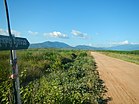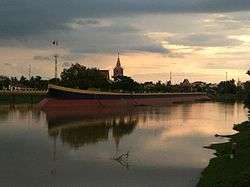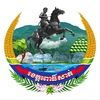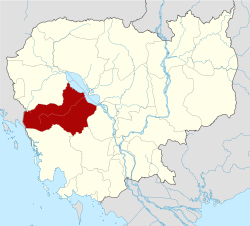Pursat Province
Pursat (Khmer: ខេត្តពោធិ៍សាត់, IPA: [poː sat]; "drifting Bodhi") is a province (khaet) of Cambodia. It is in the western part of the country and borders clockwise from the north: Battambang Province, the Tonlé Sap, Kampong Chhnang Province, Kampong Speu Province, Koh Kong Province, and Thailand. It lies between the Tonle Sap and the northern end of the Cardamom Mountains. The Pursat River bisects the province, running from the Cardamoms in the west to the Tonle Sap in the east.
Pursat Province ខេត្តពោធិ៍សាត់ | |
|---|---|
   | |
 Seal | |
 Map of Cambodia highlighting Pursat | |
| Coordinates: 12°32′N 103°55′E | |
| Country | Cambodia |
| Provincial status | 1907 |
| Capital | Pursat Municipality |
| Government | |
| • Governor | Mao Thonin (CPP) |
| Area | |
| • Total | 12,692 km2 (4,900 sq mi) |
| Area rank | 4th |
| Population (2019 census)[1] | |
| • Total | |
| • Rank | 15th |
| • Density | 32/km2 (80/sq mi) |
| • Density rank | 20th |
| Time zone | UTC+7 (ICT) |
| Dialing code | +855 |
| ISO 3166 code | KH-15 |
| Districts | 6 |
| HDI (2017) | 0.551[2] medium |
| Website | pursat |
The fourth largest province of Cambodia in area, Pursat ranks only 14th in population. The region is accessible by National Highway 5, by boat, rail and by numerous smaller roads. The capital, Pursat town, lies 174 kilometres north west of Phnom Penh by road and 106 kilometres south east of Battambang.[3]
Pursat is home to Wat Bakan, considered to be among the oldest active pagodas in Cambodia and revered as one of the most holy sites of Cambodian Buddhism.[4] The province also hosts the annual River Run Race, an event that includes 5 km and 10 km races that generally follow the path of the Pursat River for men and women, including those requiring wheelchairs. Since its inaugural race in 2007, the event has grown to the second largest of its kind in Cambodia[5]
Etymology
Pursat means "drifting bodhi" in Khmer. Po (Khmer: ពោធិ៍) is the Khmer word for bodhi, which is the tree where the Buddha became enlightened. Sat comes from "rasat" meaning "to float".
Geography
The physical geography of Pursat encompasses many bioregions ranging from densely forested mountains to fertile plains to the Tonle Sap basin. Forests cover approximately 58% of Pursat.[6] The mountains of the Cardamom range rise high in the west and southwest of the province along the border with Thailand and the coast. The land slopes toward the northeast, opening into the plains that continue into Battambang and from which much of Cambodia's rice crop is harvested. The Pursat River follows this orientation and drains into the Tonle Sap which forms Pursat's eastern boundary. Pursat is one of the nine provinces that are part of the Tonle Sap Biosphere Reserve.[7]
Economy
Thmada
Chinese investors have disbursed close to 10 billion baht to develop a new city in Thmada, a border village in Veal Veang District in the province. The new town is to be built in five phases, and about 80% of the first phase, 1,000 condominiums, has been built as of 2019, together with a luxury hotel, restaurants, casinos, and other businesses. The project is to be completed by 2022 or 2025.[8]
Agarwood
Due to the geography and climate of Pursat, Aquilaria thrives in its forest. Aquilaria species, specifically Aquilaria crassna, infected with the parasitic mold Phaeoacremonium parasitica are the source of agarwood. There was an abundance in wild agarwood in the past. Due to its distinct fragrance, the trees were sought after and felled for gift offerings to the royal family and officials.
Agarwood harvested from Pursat was the most valuable and highly in demand. In the early-1970s, "oud Cambodi" was the most sought after oud oil on the market because of the belief that it contains a psychoactive substance that affects their minds and emotions.[9]
The depletion of wild trees from rampant cutting of agarwood has resulted in the trees being listed and protected as an endangered species. Projects are being implemented to infect cultivated Aquilaria trees artificially, to produce agarwood in a sustainable manner.[10]
In 2015, Lieutenant General Ouk Kosa of Cambodia's Ministry of National Defense signed an MOU with a Singaporean company,[11] giving the company access to six million mature Aquilaria trees, which they will inoculate to produce agarwood.[12]
Administrative divisions
The province is divided into six districts and one municipality.
| ISO Code | District | Khmer |
|---|---|---|
| 15-01 | Bakan | ស្រុកបាកាន |
| 15-02 | Kandieng | ស្រុកកណ្តៀង |
| 15-03 | Krakor | ស្រុកក្រគរ |
| 15-04 | Phnum Kravanh | ស្រុកភ្នំក្រវាញ |
| 15-05 | Pursat Municipality (formerly Sampov Meas) | ក្រុងពោធិ៍សាត់ (អតីត ស្រុកសំពៅមាស) |
| 15-06 | Veal Veang | ស្រុកវាលវែង |
| 15-07 | Talou Senchey | ស្រុកតាលោសែនជ័យ |
See also

References
- "General Population Census of the Kingdom of Cambodia 2019". National Institute of Statistics. Ministry of Planning. June 2019. Retrieved 12 August 2019.
- "Sub-national HDI - Area Database - Global Data Lab". hdi.globaldatalab.org. Retrieved 2018-09-13.
- Total Road Atlas of Cambodia, Third Edition, Phnom Penh, 2006
- History of Bakan Pagoda, Kambuja Soriya Magazine, Volume 2, 2003, Buddhist Institute, Phnom Penh
- HS Manjunath (20 October 2011). "Pursat set for its fifth River run race". Phnom Penh Post. Retrieved 7 December 2013.
- O Kunka. 2005. Participation in natural forest resource management in Pursat province, Cambodia
- "Tonle Sap Biosphere Reserve Environmental Information Database". Archived from the original on 2008-09-05. Retrieved 2020-05-13.
- Waewkraihong, Jakkrit (1 July 2019). "Boom along the border". Bangkok Post. Retrieved 1 July 2019.
- Pengly, Horng. "A scent more precious than gold". Phnom Penh Post. Retrieved 2016-01-22.
- Broad, S. (1995) "Agarwood harvesting in Vietnam" TRAFFIC Bulletin 15:96
- "Memorandum of Understanding Signing (MOU): A Historic Achievement for One Plantation and Cambodia". oneplantation.asia. Retrieved 2016-02-18.
- "Soldiers, Singaporean Firm to Plant 6 Million Trees - The Cambodia Daily". The Cambodia Daily. Retrieved 2016-02-18.
External links
- United Nations World Food Programme's Food Security Web Atlas of Cambodia - Provincial Food Security Profile of Pursat
- Cambodia National and Provincial Resources Data Bank - Pursat Provincial Resources
